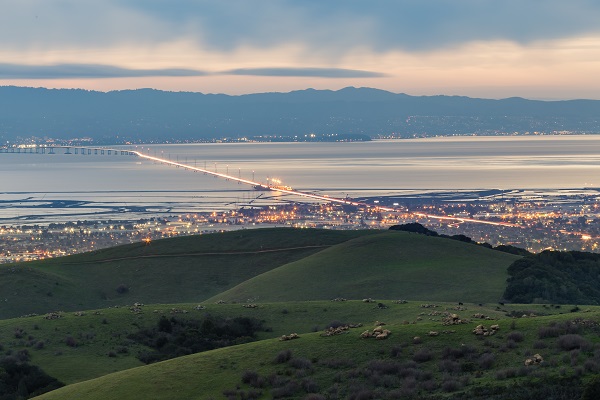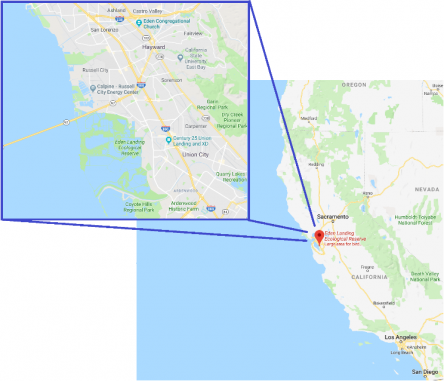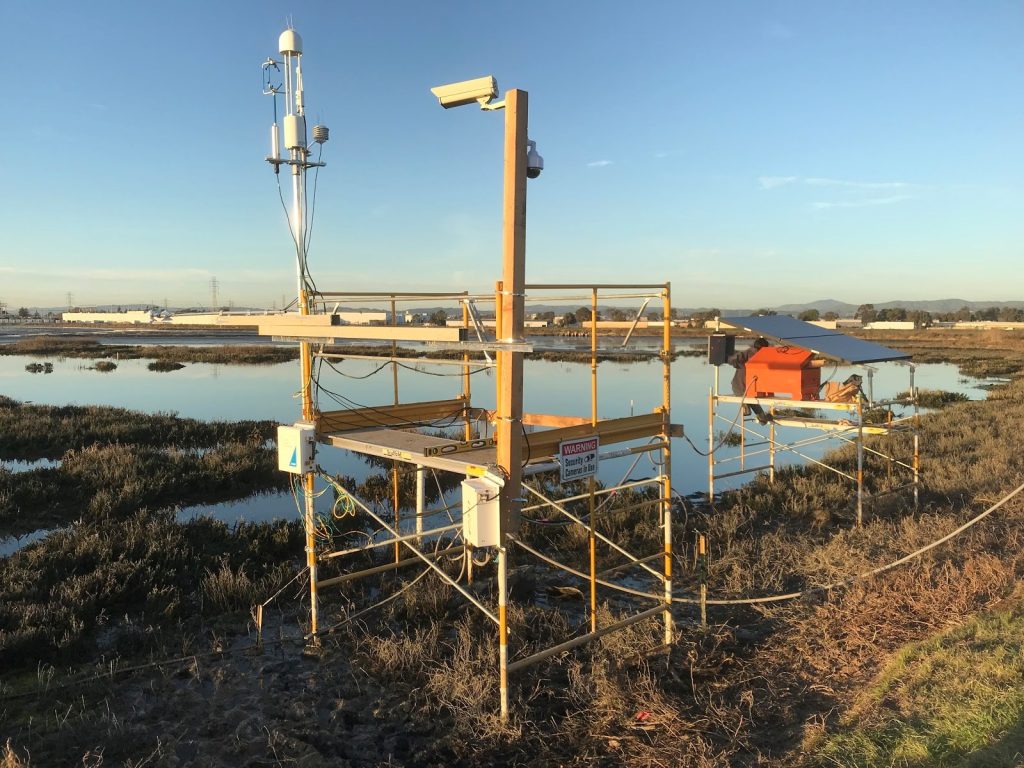Apply now to join our next cohort of Community Science Fellows and Community Leads!

Photo Courtesy of the City of Hayward, CA.
Project Title: Accounting for Climate Change Mitigation Potential of Coastal Wetlands
Location: Hayward, CA
The Team:
Laurel James, City of Hayward, [email protected], (510) 583-4303
Patty Oikawa, California State University, East Bay; [email protected], (510) 885-4068
The Initial Challenge:
The Hayward, California Thriving Earth Exchange project was launched in March 2017 with an initial goal of identifying degraded wetlands that could be restored using funding from California’s carbon markets and pursuing climate adaptation/mitigation funding to for restoration through that channel.
The Methods:
The project team partnered to design a study that would provide scientific insight to be used for development of medium- and long-range city plans concerning the local shoreline and the city’s actions relative to state carbon markets. They monitored greenhouse gas exchange at a restored tidal marsh in the Eden Landing Ecological Reserve (just south of Hayward) using the eddy covariance method (a statistical approach for measuring how gases are exchanged in natural ecosystems.) They used this method to measure how much carbon dioxide and methane entered and were emitted from the marsh over a year. The cumulative (net) gas exchange could then be used as an estimate for the climate mitigation potential of restoring wetlands further north along the Hayward shoreline.
The project team met monthly – occasionally in person, but usually via telephone – to stay in touch over the course of the project. Because this work fit in closely to existing research and priorities, the time commitment was overall quite small.

Eden Landing Ecological Reserve
The Results
This project produced an annual greenhouse gas budget (specifically, carbon dioxide and methane) of a restored tidal marsh just south of Hayward, California. This serves three purposes for the community:
The community also learned the coastal wetlands in Hayward are healthier than expected. This knowledge can help make the case for converting additional properties into open space as opportunities arise.
The Impact
Coastal wetlands are widely acknowledged for their ecosystem services: they provide wildlife and fisheries habitat, recreational opportunities, improve water quality, reduce erosion, control floods and more. These services convey ecological and economic benefit, as well as protection against the impacts of climate change. By providing insight into the greenhouse gas budgets of a coastal wetland, this project allows the community to understand and quantify its carbon offset potential and enables the City of Hayward to consider an initial, less visible benefit: reducing greenhouse gases for climate change mitigation.
The main impact of this collaboration is yet to come. This project feeds into a long climate planning process, but positions the city to seize climate change financing and mitigation opportunities and provides much-needed clarity and data for pursing them effectively. The data and insights gleaned from this work will feed into the city’s Shoreline Master Plan, which will serve as a roadmap for development along the city’s shoreline for decades. (The Shoreline Master Plan is currently in development, with an expected completion date of June 2020.)
Meanwhile, data about the wetlands’ greenhouse gas sequestration rates is now available for city participation in carbon markets, thus helping to finance additional climate change adaptation measures in the community.
The data collected by Patty and her lab is shared on Ameriflux, an online community of sites and scientists measuring ecosystem-scale carbon, water and energy fluxes in the Americas. Data for their site, “US-EDN” is available open-source here.
Reflections
Laurel hopes that this collaboration will encourage other cities to collaborate with local scientists to improve their ability to mitigate and adapt to climate change.
The best advice that Laurel and Patty have for other project teams is to communicate. Continued communication – even if it was a short check-in – kept them in contact and kept the collaboration alive. Communication doesn’t need to be onerous – brief emails can be plenty.
They also emphasized patience. Both science and government move slowly. Have patience and realistic goals with realistic timelines. This project has a long-term goal, and it may take several years for the full scope of its impact to manifest. There needs to be patience on all sides and recognition that these themes take time.

An eddy covariance tower installed at a restored tidal salt marsh located within the Eden Landing Ecological Reserve, San Francisco Bay, CA, USA. The tower is measuring ecosystem exchange of CO2, H2O and CH4. Photo credit: Patty Oikawa.
Hayward, California is a diverse, coastal community. It has wetlands and its industrial base situated along its coastline. The top natural resource issue Hayward faces is water supply – while the city has low per capita water consumption rates, it is understood that California will likely experience longer, more intense periods of drought as the climate changes. Hayward has extensive wetlands compared to neighboring municipalities, these delicate ecosystems will collapse as they are inundated with bay water.
Several studies analyzing the impact of sea level rise on the Hayward shoreline have been completed (the Adapting to Rising Tides Hayward Shoreline Study and a forthcoming Climate Hazard Assessment). These studies provide valuable information about inundation at different heights of sea level rise, but don’t address related hazards – for example, subsidence and changes in the water table along the shoreline, where many industrial businesses and the city’s Water Pollution Control Facility (WPCF) reside. Anecdotally, the WPCF has already experienced equipment problems due to subsidence and uplift.
Through this project, the City with the help of its scientific lead, will produce an analysis that identifies degraded wetlands that can potentially be restored using funding from California’s carbon markets. The analysis will also cover a plan for entering the carbon markets for restoration funding. Additionally, this product will include informational items for public consumption.
Laurel James is a Management Analyst in the City Manager’s Office for the City of Hayward. In her role, she is responsible for the City’s employee engagement initiatives, emergency preparedness and resilience projects including the Hayward Local Hazard Mitigation Plan, and the department’s budget. Laurel holds a master’s degree in public policy from Mills College, and has worked for the City of Hayward since 2015.
John Stefanski is a Management Analyst in the City Manager’s Office for the City of Hayward. He is responsible for overseeing the City’s Community and Media Relations Division and Redevelopment Successor Agency. John is also the project coordinator for Highspeed Hayward, a $5.5M high speed fiber infrastructure expansion project. Originally from Youngstown, Ohio, John holds a BA in Public Administration from Miami University and an MPA from the Maxwell School at Syracuse University.
Dr. Patty Oikawa is Assistant Professor in the Department of Earth and Environmental Science at Cal State University – East Bay in Hayward, CA. Her expertise is in ecosystem ecology, greenhouse gases, and biogeochemical cycling in coastal wetlands. She is in the process of trying to identify a local tidal wetland site to set up measurements of carbon dioxide and methane emissions as well as soil accretion to help understand how these systems can keep up with sea level rise. She has a PhD in Biology from the University of Virginia and a B.S. in Ecology, Evolution, and Marine Biology, University of California, Santa Barbara.
(c) 2024 Thriving Earth Exchange